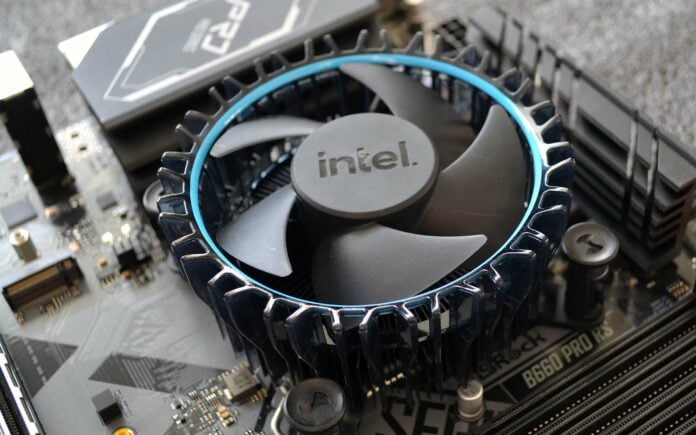Once a cottage industry, investing in good cooling for desktop processors has become big business. From simple air-based heatsinks to extravagant all-in-ones costing upwards of £300, a solution exists for all budgets and aesthetics.
There’s merit in dabbling with aftermarket cooling when overclocking, colour coordinating in a themed build, or achieving near-silent operation through heft and engineering alone.
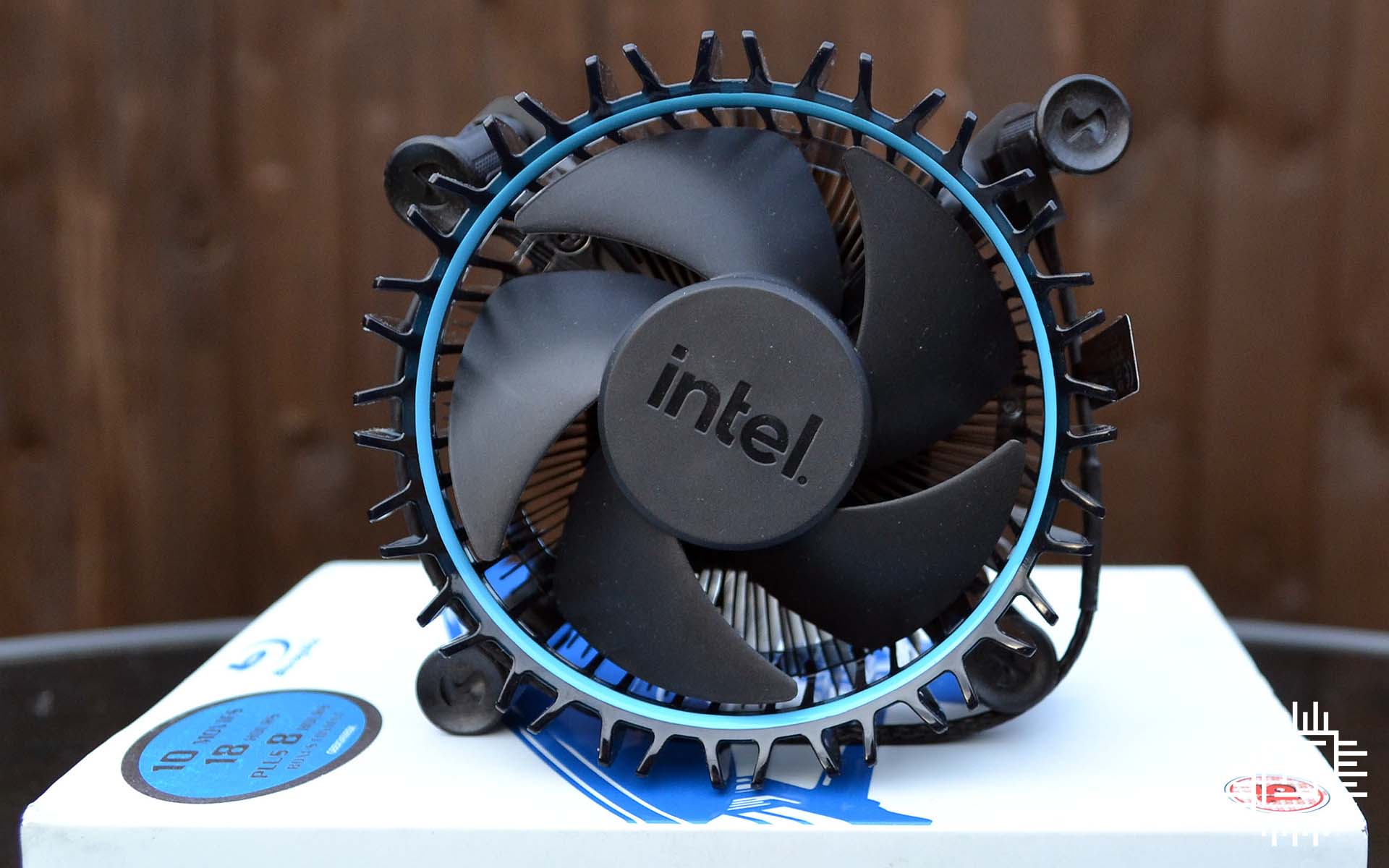

Intel Laminar RM1
£19.99
Pros
- It’s free
- Tidy aesthetics
- Acceptable performance
- Easy to install
Cons
- Pushpins
- Can get noisy
- Can’t buy separately
Club386 may earn an affiliate commission when you purchase products through links on our site.
How we test and review products.
Yet millions of desktop PCs are sold each year equipped with rudimentary heatsinks supplied by the processor manufacturer. Retail-boxed chips offered to enthusiasts tend to be packaged with coolers if wattage requirements are sedate. AMD, for example, has upped the cooler-in-box game by providing a range of rather attractive Wraith heatsinks.
Not to be outdone, or indeed outshone, Intel has also revised packaged cooling for 65W (and below) Alder Lake 12th Generation Core chips. Dubbed Laminar and shipped with 12 processors, Team Blue actually has three in-box cooler models known as RS1, RM1 and RH1.
| Laminar RS1 | Laminar RM1 | Laminar RH1 | |
|---|---|---|---|
| Design | 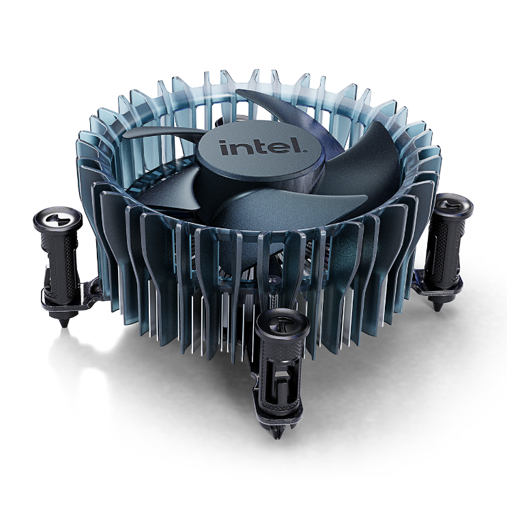 | 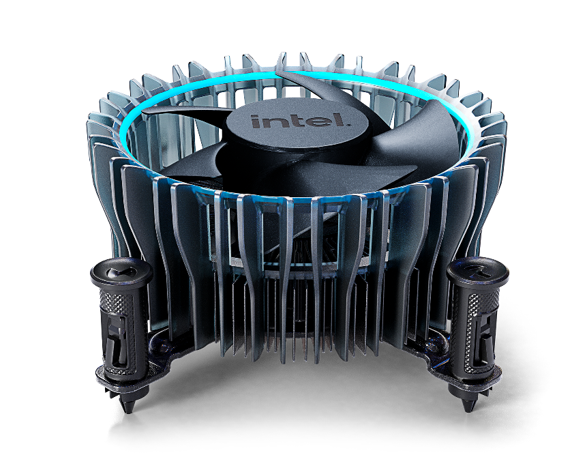 | 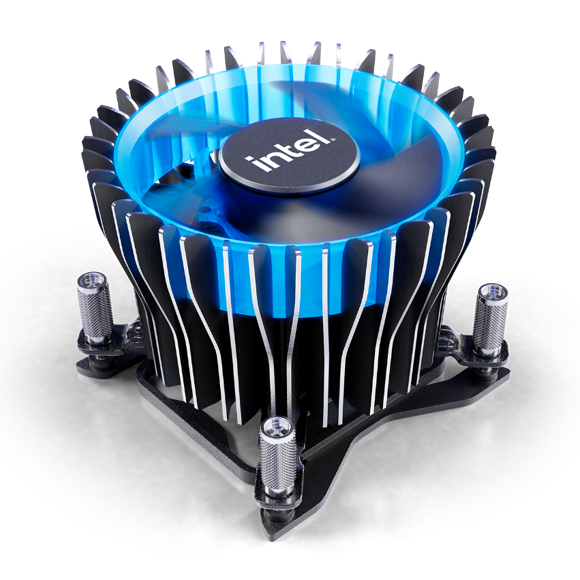 |
| Boxed with | Celeron G6900 Pentium Gold G7400 | Core i7-12700 Core i7-12700F Core i5-12500 Core i5-12400 Core i5-12400F Core i3-12300 Core i3-12100 Core i3-12100F | Core i9-12900 Core i9-12900F |
| Fastening | 4x pushpins | 4x pushpins | Metal backplate |
| TDP rating | 65W | 65W | 65W |
| Weight | 260g | 350g | 450g |
| Height | 47mm | 47mm | 69mm |
| Size | 100mm x 100mm | 100mm x 100mm | 103mm x 103mm |
| Heatsink/core material | Aluminium | Aluminium/Copper | Aluminium/Copper |
| LEDs | No | No | Yes |
| Fan min/max speed | 600/3,000RPM | 600/3,150RPM | 1,000/3,000RPM |
Laminar RS1 is the cheapest of the trio. Relatively small in size and featuring aluminium fins and core, it’s primed for use with dual-core Celeron G6900 and Pentium Gold G7400. Cooling ought to be straightforward on these 46W TDP models.
Stepping it up a notch is Laminar RM1. Expected to ship in vast quantity, it’s the cooler-in-box solution to eight popular 12th Gen processors. Compatible Core i3s ship with a default 60W TDP whilst all other chips carry a 65W TDP. Bear in mind these figures are considered the base power limits. Running at elevated maximum power ratings, known as PL2, is outside the thermal remit of this cooler.
Last but not least is the LED-infused Laminar RH1. Offering beefier construction and secured by a backplate as opposed to pushpins, it’s the most attractive of the trio.
As Club386 has reviewed the Core i3-12100F recently – and what a little belter it is – we feel a more in-depth investigation into the heatsink’s capabilities is in order.
Laminar RM1
Mid-spec Laminar RM1 is both a physical and visual improvement over stock coolers bundled a decade ago. Aluminium fins splay out from the centre in circular fashion. Protective casing, made from plastic strips arranged vertically on the outside, saves fingers from cuts. Expanding from the base to accommodate the 80mm Intel-embossed fan, build quality is surprisingly decent.
A semi-reflective blue strip adds pizzazz. Neither replaceable nor lit by LEDs, it’s a nice touch on an otherwise dark cooler.

Intel’s dreaded pushpins keep costs low and installation simple. Attached to the motherboard by pushing down on the tops until a click is heard, it takes but a minute for it to be secure, and the use of a metal retaining plate is wise. It’s not really designed for multiple installations, however, but can be removed by turning the column heads anti-clockwise a quarter turn. Unless you’re blessed with great finger strength, use a flathead screwdriver for the task; the egg-timer indents within the plastic heads are strong enough to withstand the required force.
Readers who’ve used Intel pushpin coolers before will understand careful positioning is required. The best method is to secure pushpins diagonally across from each other. Go too quickly and you risk one of the tweezer-like plastic retainers at the bottom catching on the motherboard PCB and breaking off – hands up if you’ve had a stock cooler with only three fully-working locking sections.
“hands up if you’ve had a stock cooler with only three fully-working locking sections.”
Equipped with a copper core, Intel’s pre-applied thermal paste makes a good impression, literally, on an LGA 1700 chip. A 20cm braided cable, ending in a four-pin connector, snakes off one corner and is long enough to tuck away behind a motherboard’s top heatsink for a tidy build.
We evaluate capability by running the cooler atop a stock-clocked Core i3-12100F (60W) positioned on an open test-bench, mimicking a worst-case airflow scenario, then push the wattage requirement up by installing an 89W PL2 target. Finally, we make the budget cooler cry by using a stock Core i5-12600K that’s natively plumbed with a 125W TDP. It’s not designed for this, of course, yet such a test ought to push thermal dissipation to breaking point.
Performance

Bear in mind the cooler’s job is to keep 65W TDP chips operating at reasonable temperatures without causing a racket.
Running the all-core Blender benchmark thrashes the chip and duly propels long-term power to 60W. Examination of performance figures reveals the fan, which is on at all times, cranks up from a base 1,300RPM to 2,500RPM very quickly. It then modulates depending upon exact load.
Taking the last five minutes of load into account, 65°C is a perfectly acceptable figure for a Core i3-12100F. Upping the power target to 89W, which the cooler is not supposed to manage, still reports an okay-ish figure. No thermal throttling is in evidence.
Having a bit of fun, 125W is clearly outside the scope of this heatsink. Whilst it can run the full Blender test without failure, Core i5-12600K does begin to throttle. Compared to a much larger cooler, our standard Blender benchmark run takes nine seconds longer than we have reported recently.

Temperature is one side of the equation; fan speed and noise are relatedly others. A 2,700RPM fan speed is certainly obvious but not overly distracting, even in a quiet system bereft of other cooling fans. Of particular interest to OEMs who may choose this cooler for budget systems, thereby reducing overall build cost compared to premium solutions, it can do the intended job on multiple fronts.

Laminar RM1 has to work much harder at 89W, evidenced by a higher temperature and fan speed approaching the maximum limit, though we freely admit this test is outside of the cooler’s remit and comfort zone. A 125W TDP is merely for our own kicks, and we certainly wouldn’t recommend this heatsink if you’re looking to push a CPU’s frequency and voltage potential.
Conclusion
Due to be shipped in millions of retail-boxed 65W chips, the Laminar range of Intel 12th Gen heatsinks are a decent step up from inelegant solutions of yesteryear.
RM1 is set to be the most popular, supporting eight desktop processors, and it does a reasonable job at balancing thermals and noise at a 60-65W TDP. If anything, Intel could relax the fan curve and let temperatures escalate another five degrees, for the prospect of lower noise, but we understand the reluctance when bean counters talk about elevated RMAs.
We’ve come away pleasantly surprised by aesthetics, build quality and performance of Intel’s latest in-box coolers. The Laminar RM1 may give pause to PC builders who have previously automatically shunned box solutions.
Verdict: a competent in-box cooler perfectly suited for millions of PCs.


